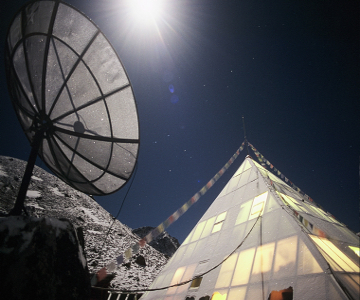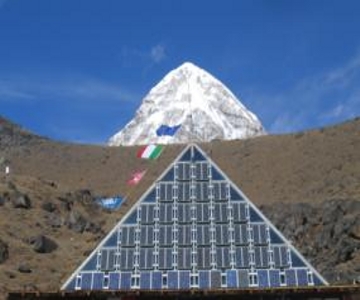












For decades, researchers like the famous Italian explorer and geologist, Prof. Ardito Desio, struggled to carry out scientific endeavors in remote high altitude areas, dependent on precarious tents and unreliable generators. By the end of the late eighties, Prof. Desio, together with climber and businessman, Agostino da Polenza, with whom he had founded the Ev-K2-CNR Project, had decided a permanent high altitude laboratory in the Himalayas was the answer. What began with a brainstorming session and a series of informal sketches on scraps of paper would one day become the famed Pyramid laboratory.
The road to the Pyramid was long, however, the first obstacle being to garner the needed funding, involve sponsors, and develop a captivating communication plan and advertising campaign. On April 17, 1988, the self-sufficient and low impact Pyramid was pre-assembled at the Milan Trade Fair, where it met with the awe and appreciation of then Italian Minister of Science, Antonio Ruberti, and representatives of the Chinese Academy of Sciences. Prof. Desio, a living legend who had been then turned 91, became the spokesperson for the ambitious scheme, attracting the interest of the national and international media.

By 1989, the initiative had been widely presented to the Italian public and the Pyramid soon became synonymous with Italian design and creativity, coupled with scientific and technological know-how. The laboratory was all set for installation in the Tingri Valley during an expedition on the Chinese face of Mt. Everest.
Political events in China, culminating in the 1989 Tiananmen Square massacre, would however led to a change in tactic. Therefore, in 1990, Ev-K2-CNR and the then Royal Nepal Academy of Science and Technology (RONAST), signed an agreement for the installation of the Pyramid on the Nepali side of Everest in the Sagarmatha National Park.
While the support of the Italian Air Force had been promised to help transport the laboratory to Nepal, authorization from the Nepali government for landing military aircraft on its soil proved to be a considerably lengthy process. Thus, cargo planes and ships docking in Calcutta, India were used to transport the 3000+ kgs of equipment to its destination in a complex logistics maneuver skillfully managed by Da Polenza and the Ev-K2-CNR secretariat.

The laboratory was installed and became operational in September 1990. Not only did the Pyramid soon become a fundamental scientific outpost for researchers and technicians, but it also grew to be known as a point of reference for local populations and tourists who could take advantage of the advanced telecommunications systems available there to send urgent messages to Kathmandu or abroad.
The Pyramid International Laboratory/Observatory was officially inaugurated in October or 1990, by the Prime Minister of Nepal, a RONAST officer, the Italian Ambassador in Kathmandu, Agostino Da Polenza and the incredible Ardito Desio, who, at the age of 93, would not miss the historic occasion, making the trip personally to the Pyramid's 5,050 meters a.s.l.
Since then, this flagship of international high altitude scientific research has become the symbol of Ev-K2-CNR and a point of pride for the Nepali and Italian governments.